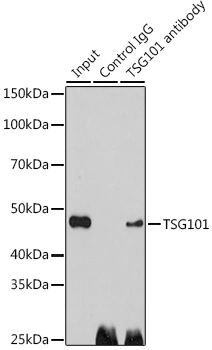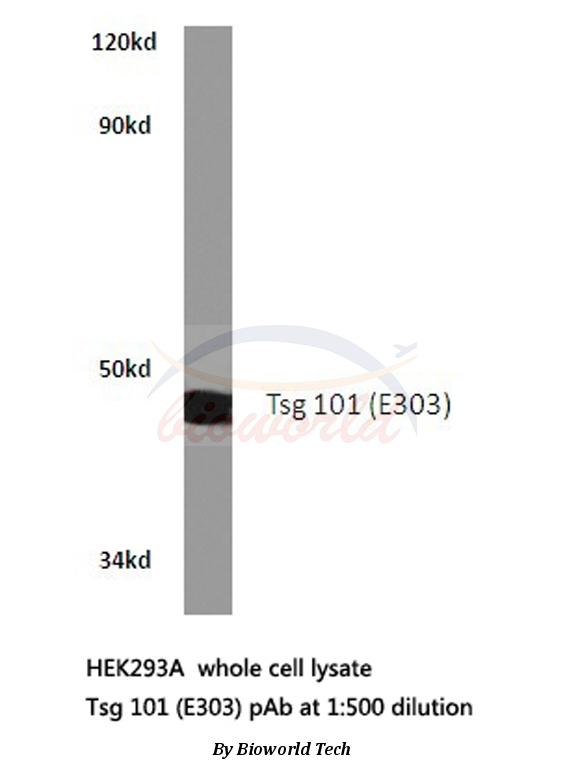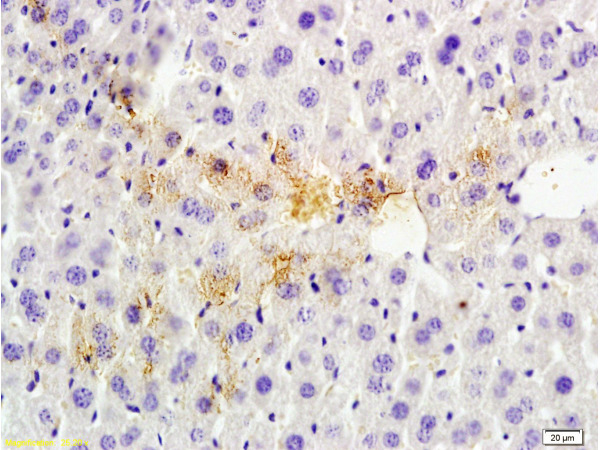TSG101 antibody
GTX118736
ApplicationsImmunoPrecipitation, Western Blot, ELISA, ImmunoHistoChemistry, ImmunoHistoChemistry Paraffin
Product group Antibodies
TargetTSG101
Overview
- SupplierGeneTex
- Product NameTSG101 antibody
- Delivery Days Customer9
- Application Supplier NoteWB: 1:500-1:3000. IHC-P: 1:100-1:1000. IP: 1:100-1:500. ELISA: 1:1000-1:10000. *Optimal dilutions/concentrations should be determined by the researcher.Not tested in other applications.
- ApplicationsImmunoPrecipitation, Western Blot, ELISA, ImmunoHistoChemistry, ImmunoHistoChemistry Paraffin
- CertificationResearch Use Only
- ClonalityPolyclonal
- Concentration1.42 mg/ml
- ConjugateUnconjugated
- Gene ID7251
- Target nameTSG101
- Target descriptiontumor susceptibility 101
- Target synonymsTSG10, VPS23, tumor susceptibility gene 101 protein, ESCRT-I complex subunit TSG101, tumor susceptibility gene 10, tumor susceptibility gene 101, tumor susceptibility protein
- HostRabbit
- IsotypeIgG
- Protein IDQ99816
- Protein NameTumor susceptibility gene 101 protein
- Scientific DescriptionThe protein encoded by this gene belongs to a group of apparently inactive homologs of ubiquitin-conjugating enzymes. The gene product contains a coiled-coil domain that interacts with stathmin, a cytosolic phosphoprotein implicated in tumorigenesis. The protein may play a role in cell growth and differentiation and act as a negative growth regulator. In vitro steady-state expression of this tumor susceptibility gene appears to be important for maintenance of genomic stability and cell cycle regulation. Mutations and alternative splicing in this gene occur in high frequency in breast cancer and suggest that defects occur during breast cancer tumorigenesis and/or progression. [provided by RefSeq]
- Storage Instruction-20°C or -80°C,2°C to 8°C
- UNSPSC12352203
References
- Lin Z, Shibuya Y, Imai Y, et al. Therapeutic Potential of Adipose-Derived Stem Cell-Conditioned Medium and Extracellular Vesicles in an In Vitro Radiation-Induced Skin Injury Model. Int J Mol Sci. 2023,24(24). doi: 10.3390/ijms242417214Read this paper
- Hsu XR, Wu JE, Wu YY, et al. Exosomal long noncoding RNA MLETA1 promotes tumor progression and metastasis by regulating the miR-186-5p/EGFR and miR-497-5p/IGF1R axes in non-small cell lung cancer. J Exp Clin Cancer Res. 2023,42(1):283. doi: 10.1186/s13046-023-02859-yRead this paper
- Chan L, Hsu W, Chen KY, et al. Therapeutic Effect of Human Adipocyte-derived Stem Cell-derived Exosomes on a Transgenic Mouse Model of Parkinson's Disease. In Vivo. 2023,37(5):2028-2038. doi: 10.21873/invivo.13300Read this paper
- Benayas B, Morales J, Gori A, et al. Proof of concept of using a membrane-sensing peptide for sEVs affinity-based isolation. Front Bioeng Biotechnol. 2023,11:1238898. doi: 10.3389/fbioe.2023.1238898Read this paper
- Lim K, Nishide G, Yoshida T, et al. Millisecond dynamic of SARS-CoV-2 spike and its interaction with ACE2 receptor and small extracellular vesicles. J Extracell Vesicles. 2021,10(14):e12170. doi: 10.1002/jev2.12170Read this paper
- Clerici SP, Peppelenbosch M, Fuhler G, et al. Colorectal Cancer Cell-Derived Small Extracellular Vesicles Educate Human Fibroblasts to Stimulate Migratory Capacity. Front Cell Dev Biol. 2021,9:696373. doi: 10.3389/fcell.2021.696373Read this paper
- Chung CC, Chan L, Chen JH, et al. Neurofilament light chain level in plasma extracellular vesicles and Parkinson's disease. Ther Adv Neurol Disord. 2020,13:1756286420975917. doi: 10.1177/1756286420975917Read this paper
- Chung CC, Huang PH, Chan L, et al. Plasma Exosomal Brain-Derived Neurotrophic Factor Correlated with the Postural Instability and Gait Disturbance-Related Motor Symptoms in Patients with Parkinson's Disease. Diagnostics (Basel). 2020,10(9). doi: 10.3390/diagnostics10090684Read this paper
- Jean-Toussaint R, Tian Y, Chaudhuri AD, et al. Proteome characterization of small extracellular vesicles from spared nerve injury model of neuropathic pain. J Proteomics. 2020,211:103540. doi: 10.1016/j.jprot.2019.103540Read this paper
- Song HY, Chien CS, Yarmishyn AA, et al. Generation of GLA-Knockout Human Embryonic Stem Cell Lines to Model Autophagic Dysfunction and Exosome Secretion in Fabry Disease-Associated Hypertrophic Cardiomyopathy. Cells. 2019,8(4). doi: 10.3390/cells8040327Read this paper






